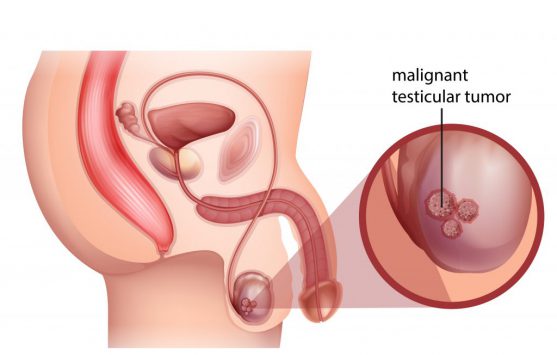Based on their occurrences, some cancers are considered common and some rare. Testicular cancer is among the latter and is said to be rare both worldwide and in India, with an incidence of less than 1 per 1 lakh men in a year.
As the name goes, testicular cancer develops in the testicles, also called testes, that are a part of the male reproductive system. Each man normally has 2 testicles that are located in a sac-like structure called the scrotum, just below the penis.
It is the testes that are responsible for the production of sperms and releasing the male sex hormone testosterone. Testicular cancer develops within these testicles. The most common type of testicular cancer develops in the sperm-producing cells called germ cells.
Although a male of any age can develop this type of cancer, it is mostly seen in men between the ages 20 to 45 years.

How can I check if I have testicular cancer?
Testicular cancer is easily diagnosed and the signs and symptoms appear in the early stages of the disease itself. One of the earliest symptoms of this cancer is the presence of a painless lump or swelling in one of the testicles.
Other signs and symptoms of testicular cancer when it has not spread to other organs include:
- A feeling of heaviness in the scrotum or lower abdomen
- Collection of fluid in the scrotum
- A dull ache in the groin area
- A change in the shape and texture of the testicles
- A difference in the firmness of the testicles
Other symptoms when testicular cancer has spread to other organs include:
- Pain in the lower back when the cancer spreads to the lymph nodes
- Difficulty in breathing, shortness of breath, chest pain, cough with or without blood are seen when testicular cancer spreads to the lungs
- Severe abdominal pain when the cancer spreads to the liver
- Frequent and sometimes severe headaches when cancer spreads to the brain.
Here are some symptoms that you should not ignore:
- Painless lumps should not be ignored and need further investigation.
- The texture and feel of the testicles should be the same all around. Slight differences in size between the two testicles are normal.
Does a lump always mean cancer?
No, some non cancerous benign conditions also can cause lumps in the testicles. These include
- Spermatocele: a cyst that develops in the epididymis
- Varicocele: enlargement of the blood vessels from the testicles
- Hydrocele: a buildup of fluid in the scrotum
- Hernia: an opening in the abdominal muscles
But this does not mean you should ignore the symptoms.
Very often men ignore these symptoms for an average of five months before consulting a doctor. During this time, the cancer spreads further making the treatment more difficult.
So no matter what the cause of the symptoms, they must be investigated by a doctor.
What tests will the doctor suggest to confirm if it is cancer?

A urologist or an oncologist would first conduct a physical examination to check for the signs of testicular cancer. If required, they might prescribe some or all of the below tests:
-
Testicular ultrasound
This is an imaging test. It is used to check any suspicious lumps inside the scrotum.
Other scans like CT scans or MRI scans of other parts of your body, like your chest, may be asked for if the doctor wants to see if there is spread to other parts of the body.
-
Blood test
Blood tests are used to check tumour markers. Tumour markers are substances made by cancer cells. The levels of tumour markers are found to be abnormally high in the blood of some people with cancer.
Commonly used tumour markers include AFP, beta HCG, and LDH.
The results of a blood test alone cannot be taken as confirmation of cancer. There can be other reasons for abnormal results.
-
Biopsy:
Your doctor may not wish to confirm the diagnosis by a biopsy from the testicular mass as it is contraindicated and not performed due to the risk of accelerating tumor spread and upstaging the disease.
The diagnosis and its exact pathological nature is made out after surgical removal of testis by a separate incision made in the groin or inguinal region and not through an incision on the scrotum.
A biopsy from a swelling that developed elsewhere in abdomen or neck may however be required for confirmation of diagnosis in selected patients.
Who is at higher risk of getting testicular cancer?
While the exact cause of testicular cancer is not known, there are some factors that put you at higher risk of developing this type of cancer:
- Having an undescended testicle (a testicle that remains in the abdomen or inguinal canal)
- Having family members with testicular cancer
- Having had testicular cancer before
- Having HIV infection
Can testicular cancer be prevented?
Many of the known risk factors, such as undescended testicles, and a family history of the disease, can’t be changed. Because of these reasons, it’s almost impossible to prevent this disease.
It is possible to detect most testicular cancers in the early stage, while they are still small and have not spread. However, some testicular cancers might not cause any symptoms till the advanced stages. For this reason, screening becomes important to detect testicular cancer in the early stages.
When detected early, testicular cancers are likely to be successfully treated.
Some doctors recommend that men between the ages of 15 – 55 should examine their testicles once a month, to look for any changes. This becomes very important if you have a risk factor for testicular cancer, like family history of testicular cancer, or undescended testicles.
If detected early, testicular cancer can be cured with a very high success rate.
Can testicular cancer cause death?
One would be happy and relieved to know that about 95% of men with testicular cancer make a complete recovery after treatment completion, provided the cancer was diagnosed early.
Testicular cancer, though rare, is largely treatable. How a patient responds to testicular cancer treatment mostly depends on the stage of the disease and the overall health of the patient.
How is testicular cancer treated?
The treatment for testicular cancer, like most cancer types, is dependent upon the stage and type of cancer. While all seminomas are treated in one way, the non-seminomas as well as mixed-cell tumours are treated alike. Most often, the treatment of this cancer involves a combination of treatment options – surgery, radiotherapy, and chemotherapy. The first line of treatment in all suspected testicular tumors is usually an ‘orchiectomy’ which is the surgical removal of the affected testis. It is usually done through an incision made in the groin region and not directly through a scrotal incision. The exact pathological diagnosis of cancer is made after removal of testis and its microscopic assessment by a pathologist. Biopsy from the testicular tumor is usually contraindicated and not performed for risk of accelerating the tumor spread and upstaging the disease.
Treatment of Seminomas:
- Stage I seminomas – are completely curable and the affected testicle is completely removed by surgery. Other treatment therapies may be used after surgery.
- Stage II A seminomas- are treated the same way as the stage I seminomas but the radiation and chemotherapy dosages are higher than in stage I cases.
- Stage II B seminomas- these seminomas have spread to lymph nodes and so chemotherapy is the preferred choice of treatment. Radiation therapy may be used if the lymph nodes are not enlarged.
- Stage II C and III seminomas- Chemotherapy is the preferred choice of treatment for these seminomas and radiotherapy is not usually used.
Treatment of Non-Seminomas:
- Stage I non- seminomas- Nearly all stage I non-seminomas can be treated. The first step involves the removal of the affected testicle surgically. The subsequent treatment following the surgery depends upon the stage of the cancer. Retroperitoneal Lymph Node Dissection(RPLND) and Chemotherapy are routinely used for stage 1A and 1B non-seminomas.
- Stage II non- seminomas- The treatment of stage II A and II B non-seminomas depends upon the level of tumour markers and the extent to which the cancer had spread to the lymph nodes. Based on this, a RPLND or chemotherapy is performed.
- Stage III nonseminomas – Though most of these are diagnosed quite late, they are almost always treatable. The first step in treating them both is radical inguinal orchiectomy followed by chemotherapy.
It is natural to feel anxious and worried about being diagnosed with testicular cancer. But, after you have come to terms with your emotions, it is best to gather courage and opt for treatment. Though the cancer is rare, easily diagnosable and has a good prognosis, one still needs to fight to beat it! While people with testicular cancer may face a variety of symptoms, it is better to go for a personalised consultation to assess your case better. Here’s where you can know in detail about testicular cancer.

